#menarche
Explore tagged Tumblr posts
Text
If you are Jewish, and did/do menstruate, did your mother slap you when you got your first period?
#sorry if this is baffling/concerning i can see why it would be lol#poll#fuzzytheduck#jumblr#jewish#frumblr#jewblr#jewish stuff#ashkenazi#menstruation#periods#menstrual cycle#menarche#jewish women#jewish culture
196 notes
·
View notes
Text
Did you know your first period can reveal more than just a new chapter in puberty? 👀 Research shows that socioeconomic status, nutrition, and even childhood stress can trigger early menarche, with potential lifelong health effects. But why does the body react this way? And what does it mean for future generations? Uncover the science behind the mystery of menstruation! 🩸✨
Menarche & the Modern Girl: Unraveling the Science, Stress, and Societal Factors Behind Early Puberty
#mis-anthro musings#anthropology#medical anthropology#menarche#menstruation#periods#menstrual health#menstrual cycle#secular trend#health
1 note
·
View note
Text
every time I'm on my period it's just like. I can't believe I've been doing this for twenty years now. That's 240 periods. 1200 days. I've been bleeding for three years straight. If I had actually stuck to one period product, that would accumulate to what? 6000 tampons? 7000 pads? I'm sick of this
2 notes
·
View notes
Note
✨ — twinkle, twinkle, little star!

a headcanon from my muses’ childhood or and a nursery-rhyme they remember from that time.
Until the age of seven, Tsuna spent every waking moment with her mother, for her father was often on long sea voyages from Othard to Thavnair. When Orihime would catch wind of his ship's arrival, it would always mean a feast for the three of them to celebrate. Her mother's sekihan was a treat she always looked forward to-- and for more than just the taste. Her father was meant to reach shore once more on the week of Tsuna's coming-of-age (obitoki-no-gi), but with the invasion of the Garleans becoming an imminent threat, his voyage was delayed. Tsuna and her mother ate sekihan that day alone, unknowing that it would be the last. While not a nursery-rhyme per se, her favorite bedtime story of her mother's was the one of the Ruby Prince: a tale in which a Hyuran fisherman and an Auri princess were brought together by a Kojin and wed in a palace under the sea. Every time her mother told it, the tale would be embellished-- much to Tsuna's delight-- but what Tsuna found the most fascinating was that the son they bore was said to have had almost no scales at all.
#thank you for sending!!#never done this before for Tsuna so im stretching my legs#some notes: sekihan is sticky rice with adzuki beans usually eaten in general celebration or for a young girl's coming of age/menarche#shichi-go-san celebrates when a child reaches 3 5 and 7 but obitoki-no-gi are for girls only#so I imagine that was one of the first times Tsuna recalls wearing a kimono#as for the bedtime story-- im glad i have an in-game reason to explain her predisposition for Hyur men LOL don't @ me#asks ; playing postmoogle#lore ; weaving a story.
3 notes
·
View notes
Text
cis people shouldnt write about gender any more
#.din#.txt#cis woman discussing feminist separatist utopias: obviously women never orchestratte a status quo. thats dumb. now the phallocentric man---#girl. page 3 of women's shore is about a Menarche Party. be so for real.
1 note
·
View note
Note
is it normal for your boobs to not be growing a lot or for me not to have my period…? i’m 13, and everyone else is ahead of me. :(
Hi Anon,
Here's the normal flow of puberty:
breast development (thelarche) -> the first step is the development of "breast buds," little pads of glandular tissue just behind the nipple
adrenal glands start working to make androgens, so you start getting pubic and armpit hair, developing BO, maybe acne
growth spurt
menses starts (menarche)
There's a pretty wide range of what's considered "normal" with the onset of puberty. Some girls/AFAB kids will notice the onset of breast development (thelarche) as early as 8, and others may not begin until some point after age 12. The "average" can vary based on geographic location, race and ethnicity, and nutritional status. In the USA, about 95% of AFAB kids have undergone thelarche by age 12.
Your ask says "not growing a lot," so I'm assuming you've had some breast development. Some breast development but no period by age 13 is totally normal. Once it's started, some people develop breasts quickly, some slowly, some get large breasts, some always remain small. Your period should follow within around 2 years of whenever your breast development started.
This is why your pediatrician asks to look at your chest and private parts, as embarrassing as that may seem. If you haven't had any nipple changes at all by age 13, your pediatrician refer you to an endocrinologist or will get some bloodwork done to make sure there isn't anything going on with your hormone levels. There are a lot of different reasons why the hormones may not be coming online properly.
So, no worries, Anon! Nothing good comes of comparing ourselves to others. For every kid out there despairing they didn't get their period by age 13, there's a 9-year-old being teased for developing breasts in the 4th grade.
FWIW - I didn't get my period until I was 14, and my boobs were pretty small until I was around 18.
4 notes
·
View notes
Text
Sixth grade is 11-12 year olds. According to this CDC report, 26% of first periods happen by the 11th birthday - that is, before sixth grade.
So a quarter of children would not be allowed to ask their teaching why they are bleeding.
Utterly shameful and ridiculous.
House Bill 1069, also known as the "Don't Say Period" bill, which passed in Florida's Republican-controlled House at the end of March, means what you think it means.
The bill proposes banning any form of health education until sixth grade and would prohibit students from asking questions about menstruation, including about their own first periods, which frequently occur before the sixth grade. If passed by Florida's Senate and signed into law by Republican Gov. Ron DeSantis, the ban will be effective July 1.
9K notes
·
View notes
Text
#first period signs#gynecologist in mumbai#menarche age#symptoms of menarche#bombay hospital mumbai gynaecologist#best lady gynecologist mumbai#female gynecologist in mumbai
0 notes
Text
My official sex ed about periods happened in 4th grade, and it was two months too late. My precocious puberty would have been far more traumatic if I didn't know what periods were when I had my menarche (a paper actually did an article on precocious puberty in response to this, and menstrual stigma makes the social isolation so much worse).
The appropriate age to teach children about periods is when they're old enough to ask, and if the child isn't super clingy and following their mom into the bathroom, I imagine it's when they're aware enough of their surroundings to ask what the menstrual products they see in the store are for.
(Teaching kids what puberty is well before they should have it and being open about all aspects of anatomy also facilitates proper medical intervention for precocious puberty. If they're in a household where they'll tell their parents when they notice their first pubic hair, then an appointment with their pediatrician can be made and medical intervention discussed.)

“So if little girls experience their menstrual cycle in 5th grade or 4th grade, will that prohibit conversations from them since they are in the grade lower than sixth grade?” asked state Rep. Ashley Gantt, a Democrat who taught in public schools and noted that girls as young as 10 can begin having periods.
“It would,” McClain responded.
Unbelievable. Link to article.
#puberty blockers are more effective and with less side effects the sooner you get on them#if an afab person with precocious puberty only gets treated at menarche theyll expeirence a level of chemical menopause#catch it early and everything is fine#...ok admitely this kind of became precocious puberty awarenese#but thats a cause thats very important to me
84K notes
·
View notes
Text

Trigun body horror week
Day 2 - Skin
Menarche
Do you ever wonder if Knives was afraid, the first time he sprouted blades instead of feathers? Would have he been less terrified, if he wasn't alone?
Do you ever wonder if he begged for his brother to come and help him understand?
Do you think it hurt?
#trigunbodyhorrorweek#trigun#trigun maximum#millions knives#cw: gore#did this in a rush but honestly quite happy with the result#but mmmmmaybe when I'll be less overworked i'll rework it a lil#chronart
531 notes
·
View notes
Text
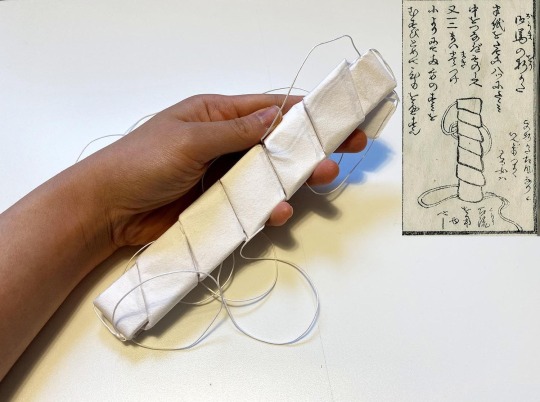
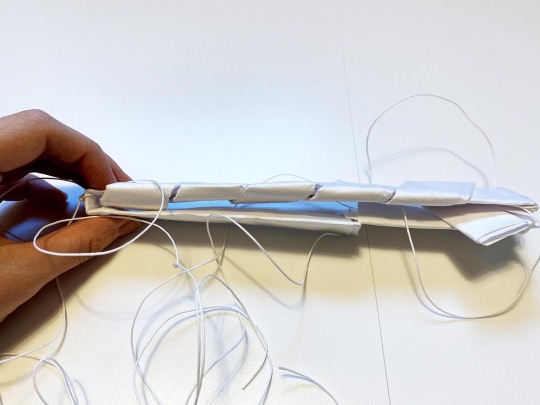
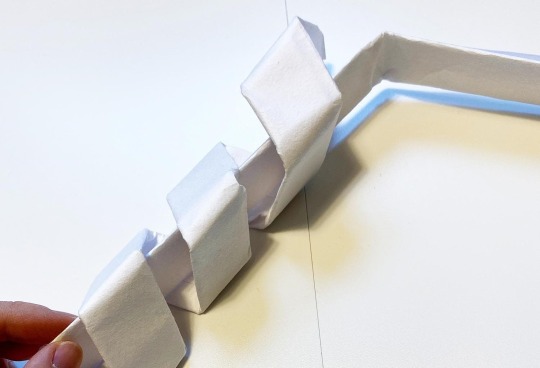
Cw: We are going to talk here about periods, and sex education in the past. Read this note according to your own sensibilities :)
How women dealt with periods during Edo period, article by shunga enthousiast Shungirl who made a paper pad following instructions found in makura bunko 枕文庫 - ie ancient sex books illustrated with erotic ukiyoe.
One of such makura bunko is 渓斎英泉 Keisai Eisen's 閨中紀聞-枕文庫, first published in 1822. It details Chinese remedies recipes for menstrual pains and irregularities, give tips about sex, and information about menstruations and pregnancy. From a modern point of view, some beliefs are outdated, but it was then such a bestseller it went through several reeditions.
Several words were apparently in use during Edo era to designates menstrual period: keisui 経水, gekkei 月経, tsukiyaku 月水, etc.
When girls went throught their first period, their females relatives or nannies would taught them how to deal with them. One method was to use paper as sanitary products (please note people without easy access to paper probably dealt with periods differently).
__________ 御馬 paper pads
Sanitary pads, such as the one recreated above by Shungirl, were then called mima 御馬 (probably as a pun on true "mima" which were then fine horses own by noblemen, or attached to sanctuaries as mounts for gods etc) or simply ouma お馬 ("honorable" horse).
Ouma were made from inexpensive recycled paper called Asakusagami 浅草紙. Sheets were folded 8 times, tied with twisted paper strings (koyori 紙縒), and then wrapped with another layer of folded paper. It was secured once again with paper strings.
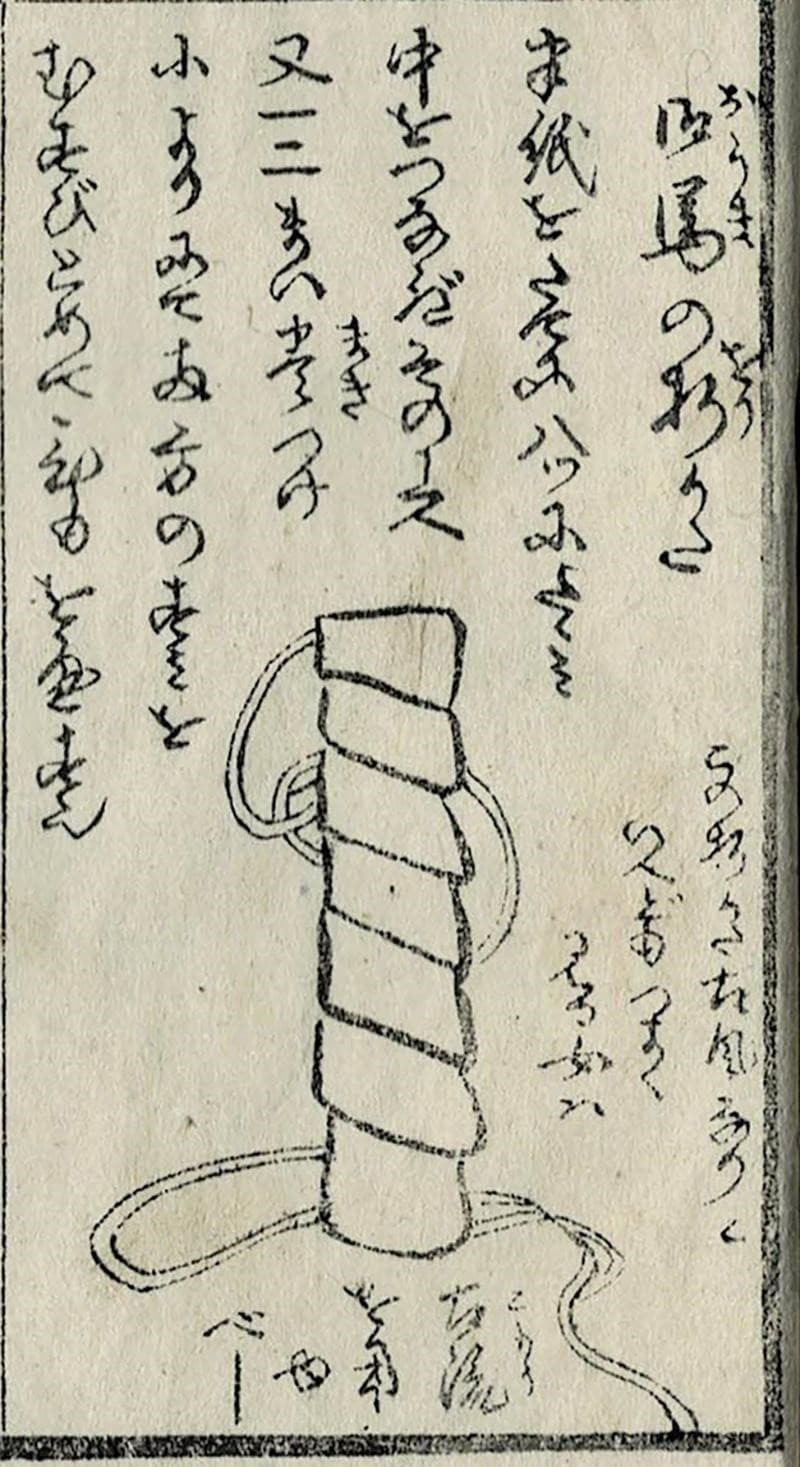
Part of the strings could be left long so to tie around the waist, or/and pad was hold into place by wearing fundoshi 褌 loincloth (which would also help prevent leaking on inner tights).
Asakusagami quality was low (it was also used as toilet paper) so paper pads had to be changed often, meaning you had to fold quite a lot of them to go through your period!
Shungirl folded the pad above following instructions found in the book 実娯教絵抄, which provided several other "models":
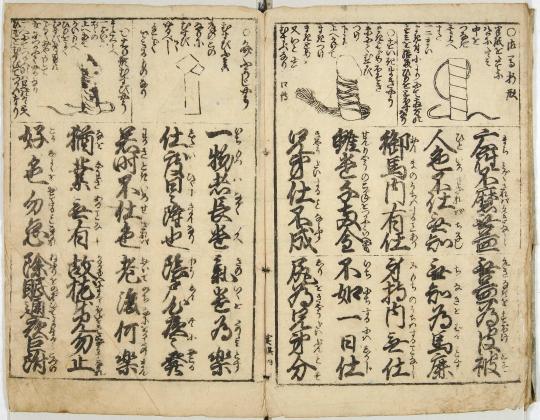
__________ 詰め紙 paper tampons
Another method for dealing with periods were tampon-like paper bundles which were inserted into the vagina, the 詰め紙 (tsumeshi? I am not sure of the reading).
This method may have first appeared in red-light districts (?). Beside its use for periods, prostitutes also used those tampons as method of contraception (OP has an interesting article on this subject).
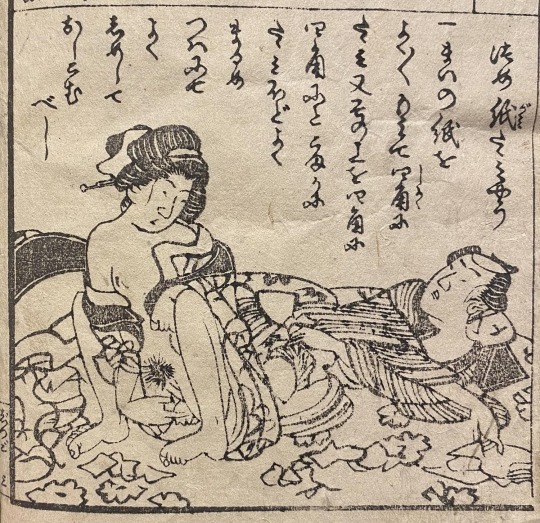
By the end of Edo period and into Meiji, paper tampons were widely used even by women who were not prostitutes - despite voices branding this method as unsanitary.
__________ About girls' coming of age rites
Menarche (first period) was an important milestone for girls, and was celebrated as such via specific rites (shochō o iwau 初潮を祝). Those differed a lot from places to places, and also depended on social status.
Celebrations would concern close family, but often spread to wider community who could received for example a festive meal (sekihan 赤飯) for the occasion (some Edo era senryû poems stress how mortifying this publicity could be!).
Interestingly, some traditions were also pretty sweet: in some places, mothers would sew 3 stiches into their daughter's underskirt (koshimaki 腰巻き) as a good luck charm, hoping their periods would last only 3 days <3
Those rites were part of coming of age traditions (seijoshiki 成女式) which marked the start of a young woman adulthood. Another example is the blackening of teeth (ohaguro お歯黒) which usually started around 16-17 years old.
Celebrating menarche publicly was a way of advertising that the girl was no longer a child and would "soon" be a bride. Yet, if menarche often took place around 13-14 years old, in reality it was somehow unusual to have girls married so soon!
Before marriage, especially in non-noble/samurai families, young women often started their sexual life via flings or yobai 夜這い ("night crawling" ie pseudo-secret nighttime encounters) before any wedding actually took place.
#cw: periods#cw: sex mention#japan#japanese history#edo period#edo era#periods#sex education#sex history#sanitary pads#tampons#paper pads#ouma#mima#paper tampons#tsumeshi#coming of age rites#ressources#references
620 notes
·
View notes
Text

Hibrides at the annual Rites to Anaemache on the Brilla River, checking to make sure she's doing this right. (Feat. a rather docile captive-bred leucistic hespaean, which has no fucking idea that it's a valuable offering and is about to die).
The hand position here is one of three key gestures against evil, a basic method of self-purification that can dispel minor evils, in this case being used to purify oneself before entering the sanctified riverbank.
Under normal conditions, yearly festivals are held during the peak of the dry season throughout Imperial Wardin, taking place at one or more temples to Anaemache that can be found on the banks of each major river. Anaemache is the Face of God that looks upon fresh water, rivers, rains, seasonal flooding, cyclic fertility, fertility of wild plants, the fertility of crops, female fertility, and pregnancies.
The rites have a set date at each temple (which may differ across the region due to variance in the average timing of the wet season), and take place over a full day, from one sunrise to the next.
The rites have a dual function. It takes place at the height of the dry season to encourage the return of the rains and the health of the river via the mass offerings that occur, and to impart Anaemache's blessings onto attendants. Most attendees are women, though farmers and other agricultural laborers will often attend regardless of gender. It is considered ideal for all women of marriageable age (a category which includes young girls who have reached menarche) to attend yearly to ensure their fertility, but this often lengthy journey is impractical for the average person to take every year, and in practice most women who attend for personal fertility matters are those who are pregnant or actively seeking pregnancy.
Most bring offerings to the river, the most basic of which can be grains, fruits, spices, or flowers (it must be a seasonal growth, ideally one that requires the rains to occur), and the best of which are sacred animals to Anaemache such as the reed duck or hespaean. Sacrificial stock vendors will often set up camp near the river temples (though are banned from temple grounds) at this time of year to hawk live animals to pilgrims, which can be a very lucrative job when done correctly. Other vendors will sell dried flowers, grains, spices and fruit for the same purposes (a less lucrative but often more stable job).
Offerings of plant matter are cast into the river directly by the pilgrims, while animal offerings are brought to a temple priest (usually set up downriver to the rest of the crowd, they must remain in the river from the start of the rites to the end) to be properly sacrificed. The animal must first be blessed and invoked as Anaemache Itself (as it is replicating God's sacrifice in creation and becomes It at the moment of death). The act is done with a quick and deep slice across the throat, allowing all of the blood to flow directly into the river. A priest will anoint the offerer's tongue with a single droplet- the animal has become the River Face of God and its blood imparts a strong blessing, taken into the body for the effects to become physical and binding.
Important parts of the sanctified body are removed for use among the temple priesthood (in this case, mostly feathers), and the rest of the corpse is placed on a continuously maintained pyre to be burned. The ashes will be collected and scattered into the river after sunrise to mark the end of the rite.
Sacrificial river animals are liable to escape into the river when brought en-masse, and one that does is considered to have been spared and blessed by Anaemache and will be left alone. Populations of water birds around these temples will often display striking and unusual coloration due to genetic input from escaped domestic/captive bred animals.
Regardless of what one offers, the offering must be made before the offerer touches the water. The participant will then remove some or most of their clothing (the minimum is shoes, the maximum is everything BUT underwear- full genital-baring nudity is socially problematic and metaphysically vulnerable when in public, and thus avoided) and enter the water. One should ideally fully submerge themself, but touching the silt with bare feet is adequate. It is then that the participants say their prayers and ask for any specific blessings- a pregnancy, the safe delivery of a child, a bountiful harvest, fruitful trees, clean drinking water, plentiful grazing, a good stock of fish, etc.
After one says their prayers and leaves the water, their part in the rite is over and they are free to go home, or alternatively stop by the celebrations that frequently crop up along the roads. In a good year, food and drink vendors, traders, the mass of pilgrims, and other opportunists will amass and form temporary mini-towns along the roadsides (or temporarily invade nearby villages), which can be excellent places to eat, drink and/or hook up.
Hibrides has shelled out a significant amount of money to a street sacrifice vendor for a near-perfect offering, to pray that she will be blessed with a healthy pregnancy and bear a boy, mostly so that she can be done having children. The rains have been inadequate (or have outright failed) for five years at this point, and the Brilla river is scarcely more than mud. God doesn't seem to be here at all. She doesn't have her hopes up.
151 notes
·
View notes
Text
MYRISH LACE SWEEP!! you are all adorned in fabrics and threads woven by those whose labour is unrecognised, whose names are forgotten. your spinners, your weavers, your lacemakers, your pearl divers. their sons will die for your wars. their fingers bleed for your beauty, a beauty they could never afford. it's such a pretty prison, and did you ever have a choice?
#polls#of course you gay emos picked taking the black 😭#i was hoping for menarche sweep... something about the innocence (white nightgown) bloodied in the night. and it was always coming!#btw. MASSIVELY oversimplifying the medieval textile industry
108 notes
·
View notes
Text
Masterlist
some of my work contains adult and uncomfortable stuff such as problematic cross-ships, toxic behaviors, hurtful language etc. do take care of your own mental health and do not attempt works that cross your limits. please heed the warnings for each work and proceed at your own discretion.
fic requests are open! do drop an ask, your thoughts, or just a hello! i love talking to people here <3
#mana talks - for all meta analysis, headcanons, extra lore
yours, mana xoxoxo
s - smut, a- angst, f- fluff, personal favourites- 🏮

Jujutsu Kaisen
Kamo Noritoshi
The Homo Economicus in Love - (s, a, f) - | Impacts of income inequality on unethical college love, a thesis paper, aka 'i was just a bet?' trope| 🏮
#1 - Operation Kamo | college majors
See No Evil (s, a, f) - | bram stoker's dracula | 🏮
prologue
Obeisance to the Arrow (s, a, f) - | arranged marriage with Noritoshi Kamo, and all that entails... |
#1 - Omiai | #2 : The Ring Ceremony | #3 - Menarche | #4 - Cursed Bride | #4.5 - Sweet Dreams | #5 - Man and Wife and the concept art | #6 - Husbandly Duties | #7 - Jealousy, Jealousy | #8 - Ice-Cream Date | #9 : The Lady Kamo
+ drabbles arranged according to the timeline
How Was Noritoshi Kamo Found To Have Blood Manipulation? - (a, f)
Hey Handsome! - (a, f) - | Noritoshi gets hit on, right in front of you |
The Question of Heirs - (f) - | Noritoshi Kamo, concussed, talks about having kids |
An Inkling of Refuge - (a, f, hurt/comfort) - | After the massacre at Shinjuku, each other is all you have left |
[finding out that you're pregnant] - (f)
Echo - (a, f, hurt/comfort) - | When your kids inherit the Ten Shadows, Megumi Fushiguro gets to meet Divine Dog White again after 16 years| 🏮
Ryomen Sukuna
Priestess (s) - | Lord Sukuna rewards his most devoted follower |
lord!sukuna x knight!reader 1 (a, f, s) - | Cannibalism done right | 🏮
lord!sukuna x knight!reader 2 (a, f, s) - | Sukuna takes another knight|
sukuna x possessed!reader (a, f, s) - | Demonic possession <3 |
Martial arts coach! Sukuna (a, f, s) - |God-complex maniacs pining for each other| 🏮
cottagecore!Sukuna (a, f) - | Sukuna cooks for you |
"romance" (f) - | English language tutor |
Choso
Kill The Damned Phone (s, f) - | a lazy morning fu-- dammit the phone keeps ringing! |
choso x geto!kenjaku (a, f, s) - | cult leader x altar boy | 🏮
Geto Suguru
quick fic (f) - | your teen daughter wants to start dating |
cult leader!geto x secretary! reader (s, f)
ragdoll runt (a, f, s ) - | geto, weeks before defecting|🏮
Tokyo Day (a, f, s) - | meeting suguru a decade after his defection, this time as a married woman | [COMPLETED]🏮
#1 | #2 | #3 | #4
Satosugu
5 : 14 AM (a, f) - | satoru wants suguru to quit smoking |
underground boxer!geto x always-bets-on-him!gojo (a, f)
Nanami Kento
quick fic (s, f) - | Nanami Kento doesn’t know your real name, only your touch |
tired manager!nanami x kpop idol!reader (f)
Ieiri Shoko
dealer!shoko x reader (a, s)🏮
Higuruma Hiromi
swipe that nose like a credit card (s, f) - | riding his face <3 |
Gojo Satoru
Satoru At Rest (a, s, f) - | your terrible ex-boyfriend is having way too much fun haunting you |
#1 | #2 | #3
Can't get it up (s, f)
Itadori Yuuji
teenage delinquents (s, f) - | idiots in love have their first kiss |
Fushiguro Toji
Rent A BF! (f) - | young toji fushiguro x reader |
character | prologue | #1 | #2 | #2.5 | #3 | #3.5 | #4 | #5 | #6 | #6.5 | #7

73 notes
·
View notes
Text
Really need the lesser-order catholic priests that are always ordering shit like "the blood of a maiden's menarche" @ the Chipotle on Grand to know that, no, you're not "radical" for subverting the Vatican's authority, consorting with devils, imbibing strange drugs, and lying with man, woman, and beast in forbidden rites, when you literally don't even have the class consciousness to fucking tip your burrito artist. Especially if you are going to make me go all the way into the walk-in to get tears from the firstborn daughter of a whore. Tf
606 notes
·
View notes